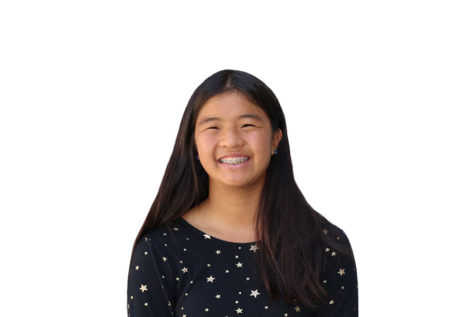
Twitter: @ardentiia

Twitter: @BinnardWyatt


Twitter: @rachmccrea

Twitter: @fran_durzo

Twitter: @ayalmeyers

Ayal Meyers and Francesca D’Urzo
Swing Club performs to “Never Had A Friend Like Me,” highlighting the inclusive nature of Heritage Fair towards cultures at Carlmont.
March 4, 2020
The roar of the crowd echoes in her ears as the spotlight beams, highlighting her still figure. All eyes are on her, and yet, she doesn’t falter as she explodes into movement, the tapping of her shoes against the floor dominating the gym.
Cheers fill the air as she pauses, but her performance isn’t over yet. Her hands reach up and begin to clap, and soon, the crowd is clapping along too as the music comes on, a backdrop for the star onstage. Chelsea Plunkett is only a freshman, but her performance captured both the heart of Carlmont’s student body and the essence of the Heritage Fair.
Every year, Heritage Fair welcomes clubs to celebrate their culture and raise awareness through the assembly, and this year was no exception.
During the weeks leading up to the Heritage Fair, ASB’s Publicity Commission paints posters to bring the assembly to life with colorful decor. This year, the commission was tasked with recreating famous artwork to emphasize the “art museum” theme that was voted upon by participating clubs.
Swing Club practices for the Heritage Fair. “We work hard around the clock, so when we preform we can inspire others to be proud of who they are,” said Hailey Hamady, a member of Swing Club.
The world is filled with all types of people of all backgrounds and experiences, and those at Carlmont High School believe it is important for rising generations to acknowledge and appreciate different cultures. Fittingly, Carlmont is in the top 20% of the most racially diverse high schools in California, according to Public School Review.
“Coming to Carlmont every day is special because you get to meet so many different people, each with their own story,” said Lise Teyssier, a sophomore.
Due to this campus diversity, Carlmont’s annual Heritage Fair aims to bring together different cultures and their clubs to put on a unique experience for the students.
“Heritage Fair makes me want to play a larger part in the community and put myself out there to represent my background. You only live to go through high school once, so I think it’s important to show who I am and that I’m unique in my own way,” Teyssier said.
Not long before this year’s Heritage Fair, clubs were putting the finishing touches on their performances to display their cultures to the rest of the school.
“We met every weekend to learn each component to our dance, and create formations to showcase the talent of each individual within our little community,” said Liana Feigelson, vice president of Korean Club.
Similarly to other clubs, Swing Club has been working around the clock, beginning as early as August to prepare for their Heritage Fair performance. The members have dedicated hours of their lives, learning all of the steps to the choreography and practicing tricks with their dance partners.
“We’re an enjoyable and welcoming group, and we get to teach others about the culture within partner dancing. For most, it’s not very familiar, but we get to introduce students to a different style of dance and show off all of our hard work,” said Marguerite Fields, a sophomore and president of Swing Club.
Another highly-anticipated performance was the Black Student Union (BSU) Club’s dance, a routine they had been practicing for weeks.
“BSU helps to showcase the talents of the black students of Carlmont, and helps to boost the social sphere of the Carlmont community. Heritage Fair’s representation from so many cultural backgrounds through creative performances helps to eliminate any stigmas created by the media in our day and age,” Reyonna Minor, a sophomore and member of BSU.
Modern-day media sometimes displays offensive opinions or jokes with underlying stigmas that may leave people feeling uneasy, according to the Washington Post. The Carlmont community makes an effort to combat online hate seen in everyday life by showcasing various identities through a celebration of everyone’s differences.
“In a society where people see culture as a defining characteristic and a way to discriminate against others, it’s important for young people to learn to embrace their own culture. It’s important for people to show who they are and be proud of their roots,” said Jono Sison, sophomore class president and a member of Filipino Club.
Likewise, Indian Club looked forward to tapping into their roots and embracing their culture through a Bollywood dance, dressed in colorful, traditional lenghas. The club showcased exciting parts of their culture through an engaging dance number choreographed by the club’s president, Amruta Thuse.
“Our Indian culture is full of dance, music, and food, and we love that we’re able to share that with other students through our Bollywood dance, and samosas we make and sell,” Thuse said.
The Polynesian (Poly) Club expressed their roots with a dance called the haka, traditionally performed before battle or when two groups come together in peace to celebrate.
“Poly Club gets to perform the haka and show the crowd what our culture does when we go to war, or what we do to scare our opponents. It’s extraordinary because not every school offers an opportunity like this,” said sophomore Dane Fifita, a member of Poly Club.
However, not all clubs performed dances. This year, Guitar Club and Ukulele Club collaborated to put together a song for the fair.
“It’s awesome to see the joy and togetherness brought by the music we play, combining a traditional Hawaiian instrument with modern music,” said Adrian Fernandez, a member of the Ukulele Club.
This year’s fair had awe-inspiring performances, meant to leave the crowd speechless. But ultimately, the fair was not just about the time spent away from class.
“I hope the awareness grows around campus, and that people don’t just go to the assembly and food sale and get nothing out of it, and I hope people don’t take for granted the communities they’re a part of, and the things that make them unique,” Sison said.
Students wait in long lines to buy food at the Heritage Week’s food sale, which is designed to showcase various ethnic foods. “It’s an extension of the Heritage Fair assembly, so clubs can show off their heritage through food,” Choudhary said.
To wrap up Carlmont’s Heritage Week, clubs set up booths in the quad to sell foods from various cultures and raise funds for next year’s fair.
“Following the Heritage Fair, this is a chance for clubs to really show off their heritage through the food that they’re selling and to fundraise for their clubs so that they have the means to run their clubs throughout the year,” said Neha Choudhary, co-supervisor of the Clubs and Culture Commission in the Associated Student Body (ASB).
The sale, that concludes Carlmont’s Heritage Week, lets students try different foods and also allows clubs to raise funds for the various expenses related to the Heritage Fair. Among the clubs selling food was Swing Club, which sold McDonald’s to celebrate their American heritage.
According to Matias Pollan, co-president of the Swing Club, they hold the booth for various reasons.
“We get a lot of people who want to join next year from running the booth,” Pollan said. “Also, we make some money that we use to buy costumes for next year so we can look uniform in the performance.”
This year, only six clubs were selling food, a huge decrease in the number from last year, according to Choudhary.
“There are fewer clubs here, but I think that’s because we didn’t just want to say it’s a food sale. We wanted to emphasize that it’s about heritage,” Choudhary said. “Usually, clubs would just sell Tpumps or something like that, which is more just for the sales, and this year, they wanted to change that.”
Choudhary thinks that these changes are good for Heritage Week since she wants to prioritize the cultural aspect of the sale.
“Even though there are fewer clubs selling, I think the quality of the event is going to be better,” Choudhary said.
Whether or not the message falls flat on students is up for debate, though, as many students only seem to view it as an alternative to the cafeteria food.
“It’s cool that you can try a bunch of different things, but, for me at least, it’s just, ‘Oh, it’s better food than the cafeteria,'” said Kelyan Taylor, a senior.
Celebrating diversity is essential to opening our minds and learning more about other cultures.
Diversity can mean a lot of different things, but at its core, it’s the acknowledgment of differences, the uniqueness that separates us in every possible way. In some respects, this individuality might seem dangerous, even a breeding ground for conflict. But it’s this exact potential for division that allows us to grow.
There’s no question that clubs are the highlight of Heritage Fair, giving performers the chance to honor their cultures. From Swing Club’s “Never Had A Friend Like Me” accompanied by wild stunts worthy of rivaling the genie’s magic to the traditional favorite Tinikling by Filipino Club, Heritage Fair never ceases to amaze.
Ultimately, it’s not just the clubs who create the environment; everyone contributes: the students in the audience dancing along to “Renegade,” the parents watching from the dance studio, the freshmen who’ve never experienced a Heritage Fair before and gaze about in wide-eyed wonder, everyone.
The Carlmont community not only experiences the culture displayed by the clubs, but it also gives back. The support for each and every culture is reflected by the cheers, the roar of the crowd, and the storm of applause following each act. It’s this support for all that drives our community and society itself, allowing us to learn from one another.
Understanding the perspectives of others while broadening our own horizons is a valuable skill, and diversity accomplishes this in a unique way that can’t be replicated elsewhere. Heritage Fair is just one cultural celebration, but it helps to foster respect and open-mindedness for other heritages. And, even though the assembly only occurs once a year, the Carlmont community continues to uphold this mindset every day.
Heritage Fair represents an opportunity, a chance for students and adults to come together and benefit from celebrating diversity. And it’s an opportunity you won’t want to miss.






